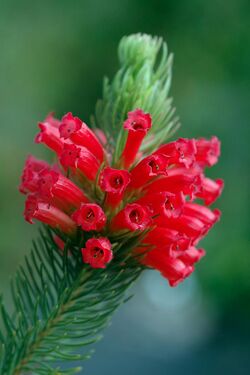Biology:Erica abietina
| Erica abietina | |
|---|---|

| |
| Scientific classification | |
| Kingdom: | Plantae |
| Clade: | Tracheophytes |
| Clade: | Angiosperms |
| Clade: | Eudicots |
| Clade: | Asterids |
| Order: | Ericales |
| Family: | Ericaceae |
| Genus: | Erica |
| Species: | E. abietina
|
| Binomial name | |
| Erica abietina | |
Erica abietina is a species of erica that is endemic to the Cape Peninsula of the Western Cape, South Africa .[1] E. abietina includes four subspecies with often highly restricted distributions and distinctive flower colours. Previous delimitation of the species has included a further three subspecies[2] which proved to be more distantly related to Cape Peninsula endemic E. abietina subspecies and are now classified under Erica grandiflora L.f. (Erica abietina subsp. aurantiaca E.G.H.Oliv. & I.M.Oliv.; Erica abietina subsp. perfoliosa E.G.H.Oliv. & I.M.Oliv.) and Erica situshiemalis E.G.H.Oliv. & Pirie.[1]
Subspecies
- Erica abietina subsp. abietina (or the red heath) is restricted to the Peninsula Sandstone Fynbos on Table Mountain, Cape Town. It produces rich-red flowers and grows up to about 1.5 metres (4 ft 11 in) in height.[3]
- Erica abietina subsp. atrorosea E.G.H.Oliv. & I.M.Oliv. (or the wine-red heath) is found only in the southern parts of Peninsula Sandstone Fynbos on the Cape Peninsula, Cape Town. It produces pinkish-purple flowers and grows up to about 1 metre (3 ft 3 in).[4]
- Erica abietina subsp. constantiana E.G.H.Oliv. & I.M.Oliv. (or the Constantiaberg heath) is restricted to the Peninsula Sandstone Fynbos in the middle of the Cape Peninsula between Constantiaberg and Chapmans Peak. It forms a small, dense shrub with bright pink flowers.
- Erica abietina subsp. diabolis E.G.H.Oliv. & I.M.Oliv. (or the devils heath) Critically endangered
This plant grows very easily and well in urban capetonian gardens and is increasingly popular as an ornamental plant.[5]
Gallery
See also
- Cape Flats Sand Fynbos
- Kenilworth Racecourse Conservation Area
- Biodiversity of Cape Town
References
- ↑ 1.0 1.1 Pirie, M. D.; Oliver, E. G. H.; Gehrke, B.; Heringer, L.; Mugrabi de Kuppler, A.; Le Maitre, N. C.; Bellstedt, D. U. (2017). "Underestimated regional species diversity in the Cape Floristic Region revealed by phylogenetic analysis of the Erica abietina/E. viscaria clade (Ericaceae)". Botanical Journal of the Linnean Society 184 (2): 185–203. doi:10.1093/botlinnean/box021. ISSN 0024-4074.
- ↑ Oliver, E. G. H.; Oliver, I. M. (2002). "The genus Erica (Ericaceae) in southern Africa: taxonomic notes 1". Bothalia 32 (1): 37–61. doi:10.4102/abc.v32i1.461. ISSN 2311-9284. https://abcjournal.org/index.php/abc/article/download/461/403.
- ↑ "Erica abietina L. subsp. abietina". SANBI. http://pza.sanbi.org/erica-abietina-subsp-abietina.
- ↑ "Erica abietina L. subsp. atrorosea E.G.H.Oliv. & I.M.Oliv.". SANBI. http://pza.sanbi.org/erica-abietina-subsp-atrorosea.
- ↑ "Erica abietina subsp. constantiana E.G.H.Oliv. & I.M.Oliv.". SANBI. http://pza.sanbi.org/erica-abietina-subsp-constantiana.
Wikidata ☰ Q5387937 entry
 |





